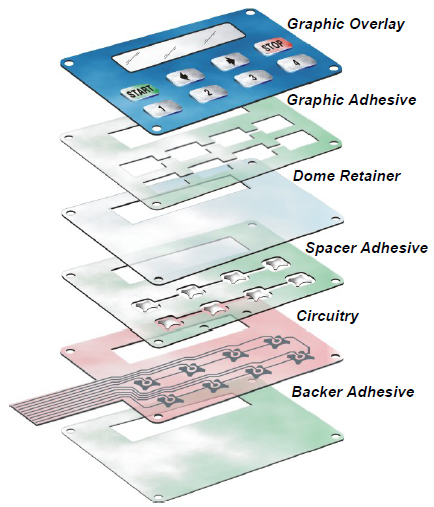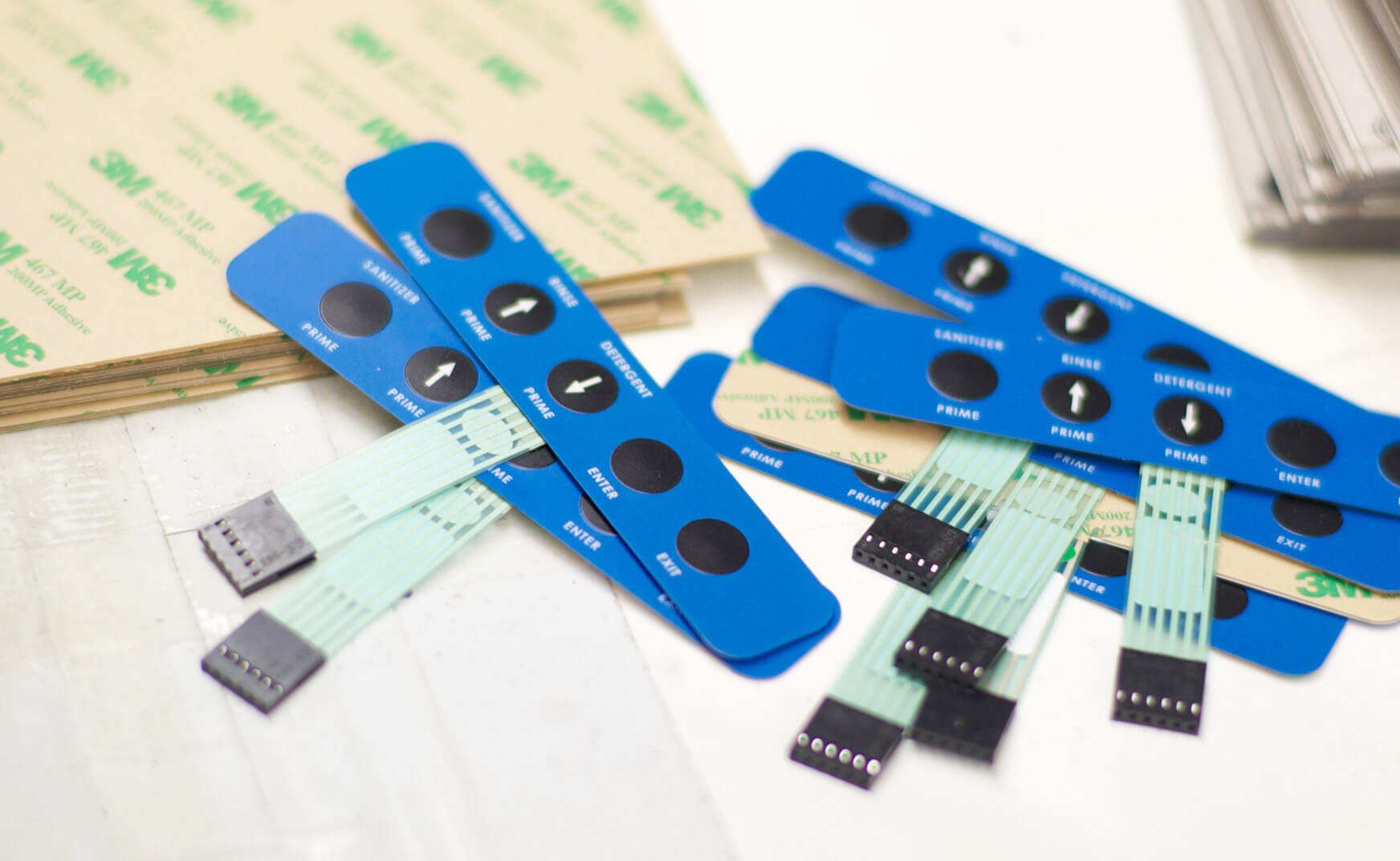Working with a authorized membrane switch manufacturer ensures compliance with regulatory standards.
Working with a authorized membrane switch manufacturer ensures compliance with regulatory standards.
Blog Article
All Concerning Membrane Switch: Understanding Its Layout and Functionality
When you think of the control user interfaces in modern gadgets, membrane switches frequently come to mind. These parts are more than simply switches; they blend layout and performance flawlessly. Understanding exactly how they function and what makes them reliable can change your perspective on daily electronics. However, there are nuances to their layout and efficiency that you may not recognize. Let's discover what collections membrane layer changes besides other control systems.
What Are Membrane Switches?

Membrane buttons can also be personalized relating to shape, size, and graphics, permitting producers to develop distinct interfaces customized to certain items. In general, membrane buttons play a substantial duty in boosting individual experience throughout a vast variety of applications.
Exactly How Membrane Switches Job
When you push a secret on a membrane layer button, it turns on a straightforward yet efficient device. The top layer, frequently constructed from flexible product, lowers onto a conductive layer beneath it. This activity bridges the void in between conductive traces, completing an electrical circuit. As quickly as the circuit closes, it sends a signal to the tool's controller, which interprets your input.
You'll discover that the tactile comments differs based on the switch design, offering either a soft click or a more noticable feedback. As soon as you launch the secret, the membrane layer go back to its original setting, resuming the circuit and stopping the signal. This process happens almost instantly, making sure a responsive customer experience.
Membrane buttons are prominent because of their durability and resistance to dust and dampness, making them suitable for different applications, from family devices to clinical devices. Comprehending this operation aids you value their extensive usage.
Key Components of Membrane Layer Switches
Understanding the key components of membrane buttons is basic for realizing their capability and style. At the core, you'll discover the graphic overlay, which provides the visual interface for users. Underneath that, there's a spacer layer that divides the circuit layers, ensuring that they don't make call until pushed. The circuit layer is where the magic happens; it is composed of conductive traces that complete the circuit when you push the switch. An additional essential element is the glue backing, permitting the switch to follow surface areas firmly. The safety layer guards against environmental variables and put on, expanding the button's lifespan. Each component plays a significant duty in making certain trusted efficiency and customer communication. By recognizing these components, you'll gain understanding into just how membrane layer switches run and their relevance in numerous applications.
Materials Made Use Of in Membrane Layer Switch Over Design
The performance and toughness of membrane layer changes heavily rely on the materials made use of in their design. You typically experience polyester and polycarbonate as key substrates due to their outstanding strength and adaptability. These products resist scrapes and chemicals, making them suitable for requiring atmospheres.
The conductive layers typically make use of silver or carbon, chosen for their integrity and conductivity. membrane switch manufacturer. Silver gives exceptional efficiency, while carbon is a cost-effective option. For the overlay, you could consider a matte or glossy finish, relying on your aesthetic needs and individual experience
Adhesives play a crucial duty as well; they bond layers safely and ensure long life. Make particular to choose adhesives that hold he said up against ecological factors like temperature and humidity. Ultimately, do not neglect the significance of a great printing method for graphics, as it boosts both functionality and visual appeal. Selecting the ideal materials will guarantee your membrane switch stands the test of time.
Layout Factors To Consider for Membrane Buttons
While designing membrane layer switches, it's essential to think about different elements that affect their performance and individual experience. Beginning by concentrating on the layout and switch size; make sure they're intuitive and very easy to browse. Think about the tactile responses you desire to provide-- will users require an obvious click or a softer touch? Furthermore, think of the materials you'll make use of, as they'll affect longevity and visual appeals.
Confirm your design accommodates environmental factors, like dampness or temperature level variants, which can influence efficiency. By carefully thinking about these aspects, you'll produce a membrane switch that enhances usability and complete satisfaction.
Applications of Membrane Buttons
Membrane layer switches are functional parts found in numerous applications, from industrial devices to customer electronic devices. You'll see their effect in makers that need resilient user interfaces and in devices that profit from smooth designs. Understanding these applications helps you value the capability and functionality of membrane buttons in daily technology.
Industrial Tools Usage
When you're looking to enhance the performance of commercial equipment, membrane switches provide a reliable service that useful content integrates toughness with easy to use style. These buttons are best for harsh atmospheres, supplying resistance to dirt, moisture, and chemicals. Embrace membrane layer switches to improve your operations and enhance general performance.
Customer Electronic Devices Combination
In the domain name of customer electronics, membrane switches play a necessary duty in improving individual communication and gadget performance. You'll discover them in gadgets like microwaves, push-button controls, and video gaming consoles, providing a smooth means to connect with innovation. Their sleek design permits very easy integration right into different products, making controls instinctive and user-friendly. With their ability to include graphics and backlighting, you can enjoy a modern visual that complements the tool's total appearance. Membrane buttons likewise assure longevity and resistance to dirt and wetness, extending the lifespan of your electronic devices. By picking membrane layer switches, you boost not simply the performance yet likewise the style of your tools, making daily interactions smooth and delightful.
Advantages and Downsides of Membrane Layer Switches
While membrane switches use an array of benefits, they likewise come with some drawbacks that you need to consider. One significant advantage is their small layout, making them perfect for space-constrained applications.

Membrane layer switches can have a shorter life expectancy compared to mechanical buttons, specifically under heavy usage. They can likewise be less responsive, which may affect customer feedback throughout procedure. Stabilizing these pros and cons will help you establish if membrane layer buttons are the best fit for your task.
Often Asked Concerns
How Lengthy Do Membrane Layer Switches Typically Last?
Membrane switches over normally last between 5 to one decade, depending upon use and ecological conditions. You'll desire to assess variables like wear, exposure to moisture, and temperature level changes to gauge their long life effectively.
Can Membrane Layer Switches Be Customized for Certain Designs?
Yes, you can personalize membrane layer switches to fit specific layouts (membrane switch manufacturer). You'll have the freedom to choose shades, forms, and layouts that match your project's requirements, guaranteeing they mix perfectly with your general visual
What Is the Cost Array for Membrane Layer Switch Over Manufacturing?
The expense variety for membrane layer button production commonly falls between $1 and $10 each, depending on factors like design intricacy, amount, and products. You can obtain quotes from manufacturers to find the ideal choice.

Are Membrane Changes Water Resistant or Resistant?
Membrane buttons can be created to be water-proof or immune, depending on materials utilized and building approaches. If you require them for damp atmospheres, assure you define those needs throughout the layout process.
Exactly How Do Membrane Layer Changes Contrast to Standard Buttons?
Membrane layer switches are typically thinner and a lot more adaptable than standard switches, offering a smooth layout. They're commonly easier to clean up and integrate, but could not offer the responsive feedback you're utilized to with mechanical choices.
Conclusion

Report this page